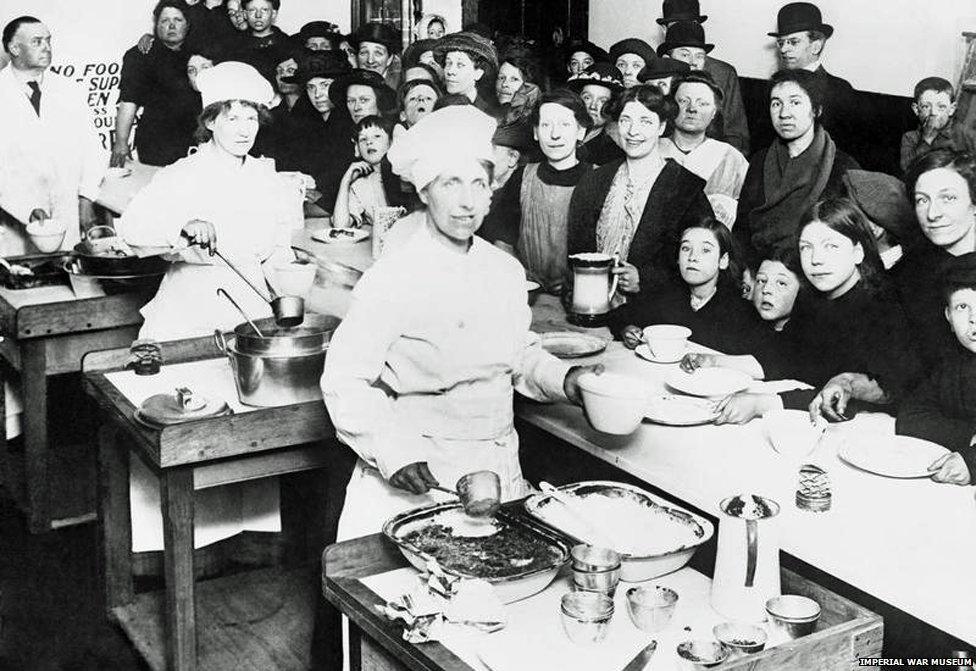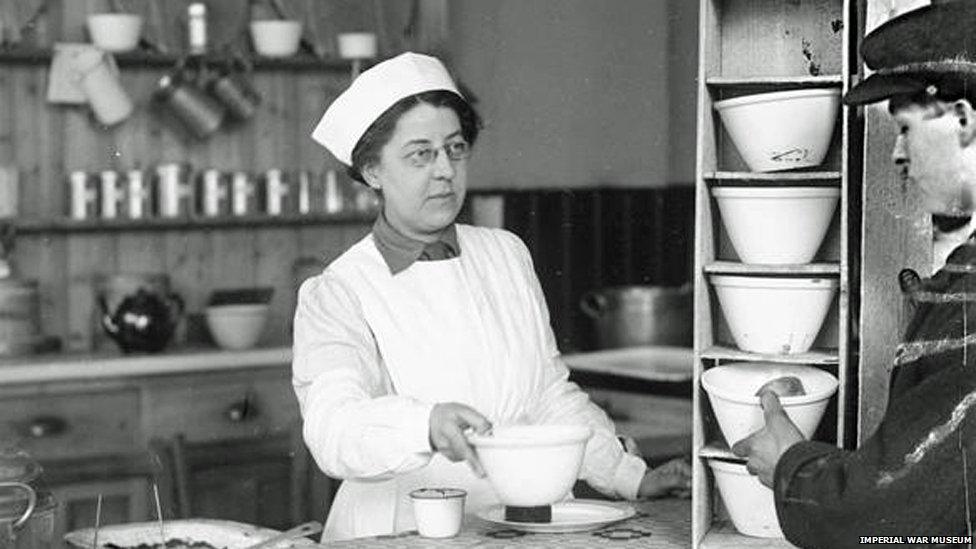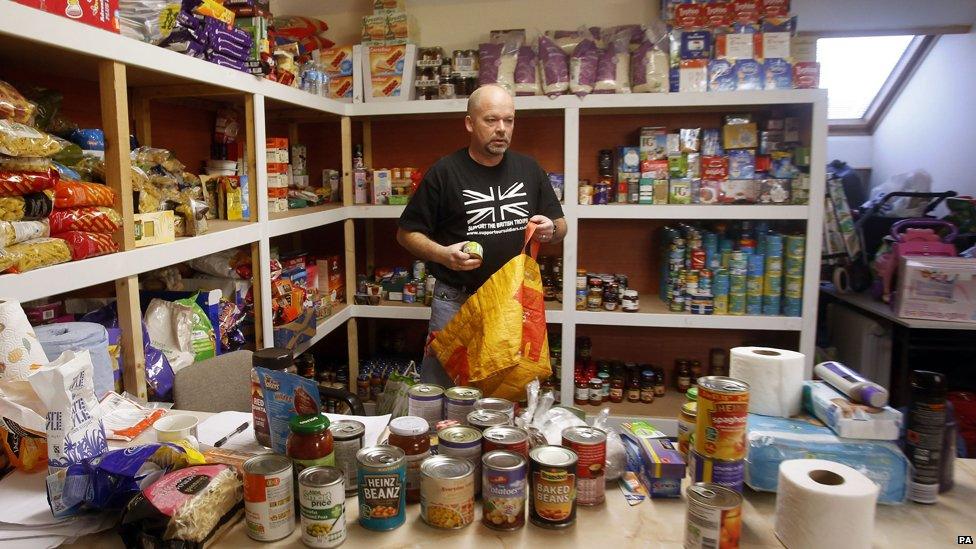The time when the government tried to feed everybody
- Published

The first national kitchen at 104 Westminster Bridge Road, opened by Queen Mary on 21 May 1917
Public canteens were set up to feed people during World War One - and they proved hugely popular. Could today's food banks learn from them, asks Adam Forrest.
A bowl of soup, a joint of meat and a portion of side vegetables cost 6d - just over £1 in today's money. Puddings, scones and cakes could be bought for as little as 1d (about 18p).
These self-service restaurants, run by local workers and partly funded by government grants, offered simple meals at subsidised prices.
In 1917, ministers in Lloyd George's government had agonised over the best way of combating hunger while Germany's U-boats disrupted Britain's food supply.
The government was keen to avoid the stigma of poverty associated with soup kitchen hand-outs, but also wanted to utilise the volunteer-run community kitchens springing up in working class communities to help deal with food shortages.
A popular fix was found - a network of public cafeteria known as "national kitchens".
The Ministry of Food instructed that the kitchens "must not resemble a soup kitchen for poorest section of society". They should feel like places "ordinary people in ordinary circumstances" could sit down together at long canteen tables for a cheap meal.
Now there are efforts to bring them back. Bryce Evans, a senior lecturer at Liverpool Hope University, has researched the WW1 kitchens and believes there are parallels with today's food banks.
"Some of the bigger kitchens were feeding up to 2,000 people a day, and the efficiency really helped cut down on waste," he says.

"Great efforts were made to make sure they were attractive places run along business lines and avoided the taint of charity. It encouraged middle-class professionals like clerks and office workers to come in and sit alongside working class families."
Evans's new research, funded by the Wellcome Trust, shows how the government's national kitchen programme grew out of grassroots community kitchens run by charities and trade unionists.
The Ministry of Food seized on their potential for efficiency. Wholesale purchasing and the collective preparation of food, they reasoned, would help cut out waste.
So local authorities were urged to open up public cafeterias wherever possible. If an outlet followed Ministry of Food guidelines, the local authority received a Whitehall grant covering half the costs.
In May 1917, Queen Mary opened the first government-backed national kitchen on Westminster Bridge Road in London. By the end of 1917, national kitchens were popping up in almost every British town and city.

Queen Mary (second left) opens the first government-backed national kitchen, May 1917
A 1918 Scarborough Post story about a national kitchen in Hull emphasised the ambition of the typical urban outlet: "The place has the appearance of being a prosperous confectionery and cafe business. The business done is enormous."
The Ministry of Food handbook criticised the "appalling ignorance" of British people when it came to preparing food, advising that more vegetables should be introduced to the diet through national kitchen menus.
The handbook also advised that each kitchen "bow to prejudice" by offering meat dishes. Gravy was to be made the "British way", by using juices and fat from the meat. The ministry also recommended any kitchens in rural settings like village halls should have food which could be "taken into the field", like Cornish pasties.
At the height of their popularity in 1918, 363 national kitchens were doing business across the country. Wartime civil servants at the Ministry of Food eagerly discussed whether national kitchens might become a "permanent national institution".
Yet the bold experiment was not to last.

The restaurant trade was not happy at the threat to private enterprise. The introduction of full rationing toward the end of the war apportioned food to each individual, damping demand for communal eating. And after the war ended, local authorities were reluctant to help fund kitchens any longer.
Within six months of Armistice Day, 120 of the kitchens had closed.
Evans believes the national kitchen movement has been too easily dismissed as merely an emergency expansion of dingy soup kitchens.
"The national kitchens were a great example of government supporting and building upon good work going on at the grassroots," he reflects.
"They were also an admirable attempt to bring people together. It wasn't a service only for the very poorest - it was an egalitarian approach to meeting people's needs, which I think we can learn from today."
Inspired by the past, the historian has now set up his own project in Liverpool called Manna Community Kitchen. Manna volunteers visit housing associations and other community spaces in the city to create a pop-up lunchtime cafe.
Meals at Manna are made using surplus food. Soups and "scouses" (a local lamb or beef stew) are sold for 50p, and people from all walks of life are encouraged to take recipes home, or even help with the cooking.
Evans thinks community kitchens like Manna might act as an alternative to food bank hand-outs, which are used by a rising number of people.
The Trussell Trust network has grown to 445 food banks, and the charity's most recent annual figures also show a 19% year-on-year increase in food bank use. Around 500,000 different people are thought to have received help over a 12-month period.
According to the charity, the most common reason for food bank use has been benefit payment delays and sanctions. But more than a fifth of food bank users - 22% - were referred because of low incomes, including people in low-paid, zero-hours or part-time work.
Most of the food banks run by the Trussell Trust charity only have the storage facilities to hand out non-perishable items like pasta, cereal and cans, though a small number do offer fresh fruit and vegetables too.

The numbers of food banks have been growing
Evans hopes community cafes might inspire food banks to rethink how they currently operate.
"There are some wonderful people who give up their time to volunteer at food banks," he says. "But I think simply handing over plastic bags of tinned and dried goods is a very limited approach. It's a wasted opportunity to do more with the huge amount of fresh food being wasted."
"I think food banks need to evolve into places with kitchens for people to cook fresh food and social spaces for people to eat together. We can do better."
Yet not everyone agrees the seeds of a new communal dining movement lie in the home front hardship of the WW1.
"Turning back to communal kitchens, it would be extremely difficult to avoid the stigma of it feeling like a service for the poor," says Martin Caraher is professor of food and health policy at Centre for Food Policy at City University.
"If they build up quite organically from a community choosing to set it up, perhaps the stigma can be overcome. But if it feels anything remotely like charity or state provision, people will feel like they're going cap in hand."
Evans argues community kitchens could also help address the nation's poor diet. At a time of rising obesity rates, he thinks it would be useful to have local authorities helping subsidise cheap cafes which only have healthy food on the menu.
"I'd like to see supermarkets get involved too by donating fresh produce," he explains. "Community kitchens, by providing cheap and healthy meals, could really help improve nutrition."
"I would love to see community kitchens blossom," adds the historian. "We have a history of egalitarian eating. Why couldn't we do it again?"
Subscribe to the BBC News Magazine's email newsletter, external to get articles sent to your inbox.